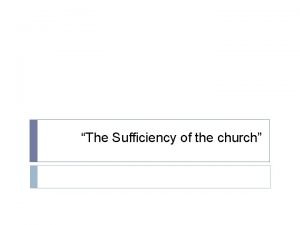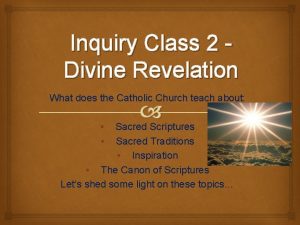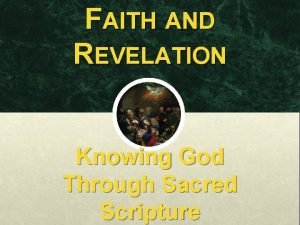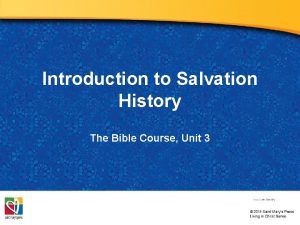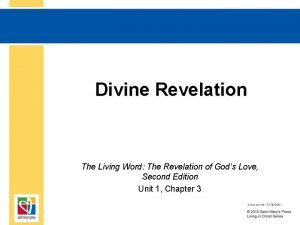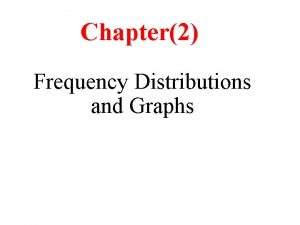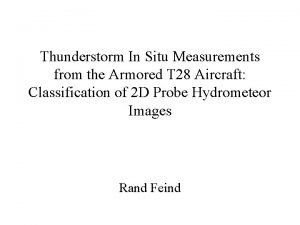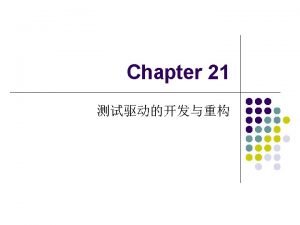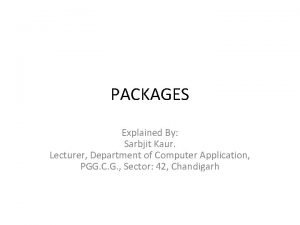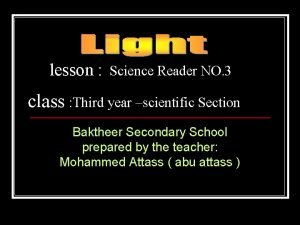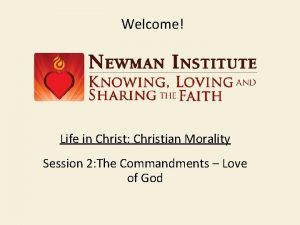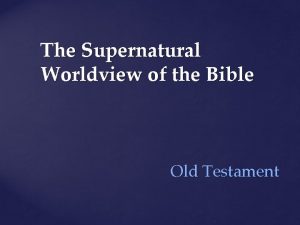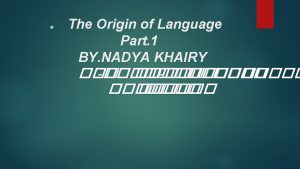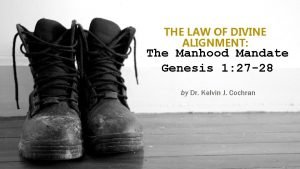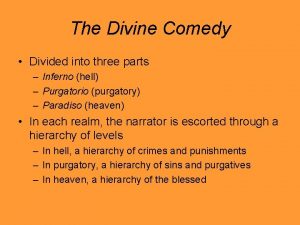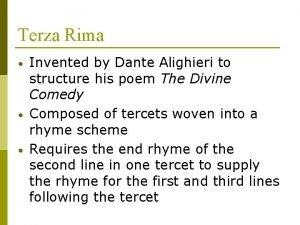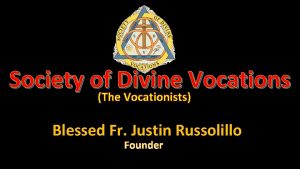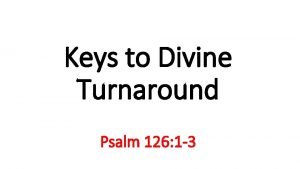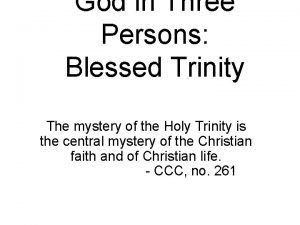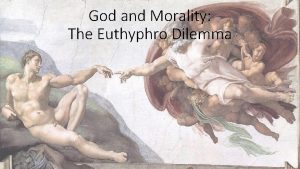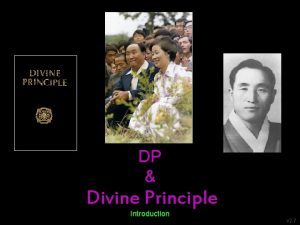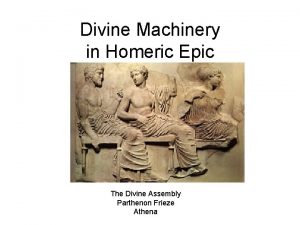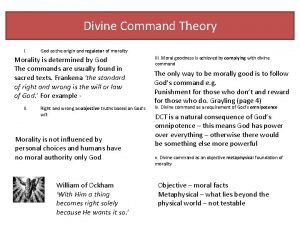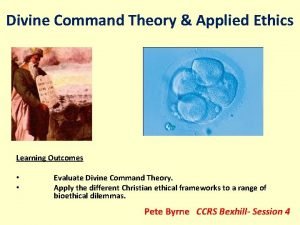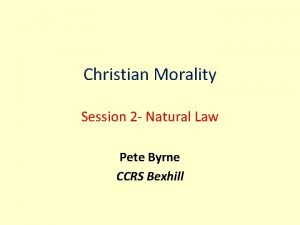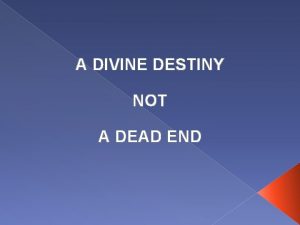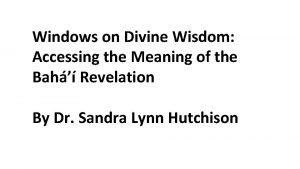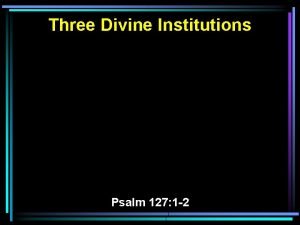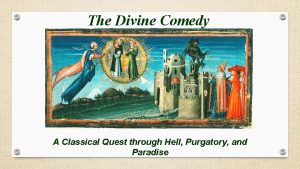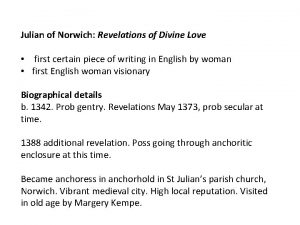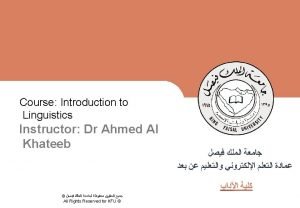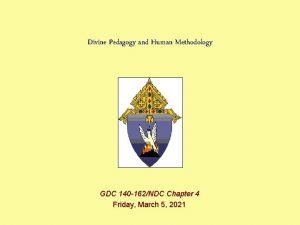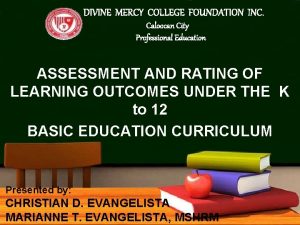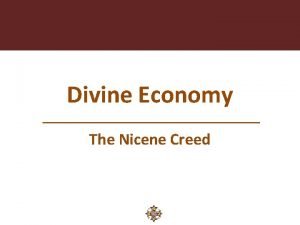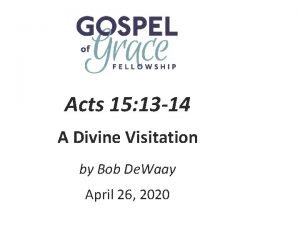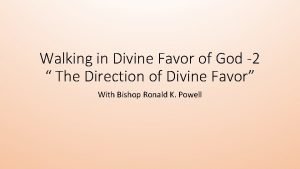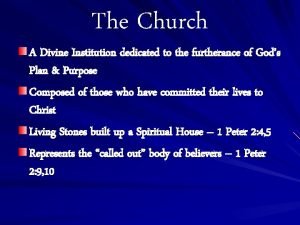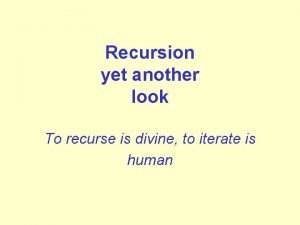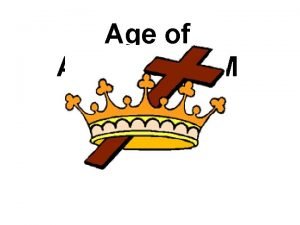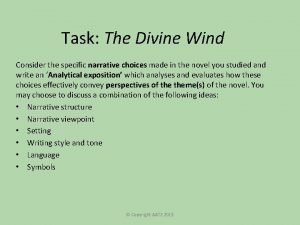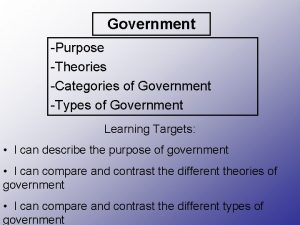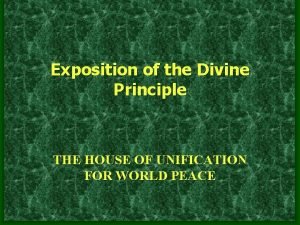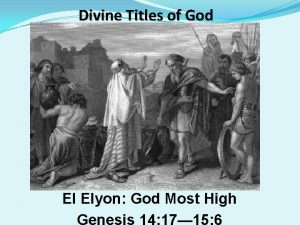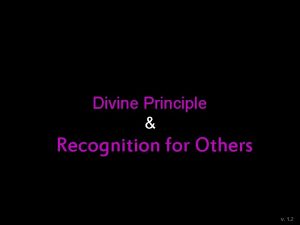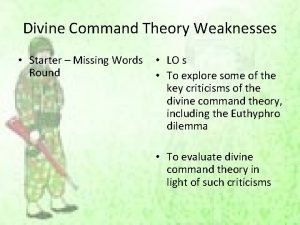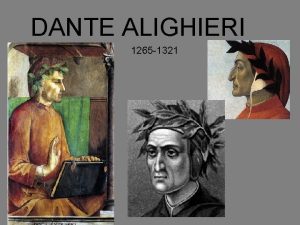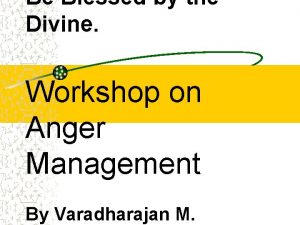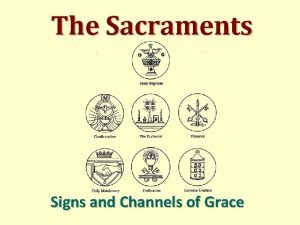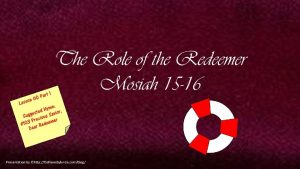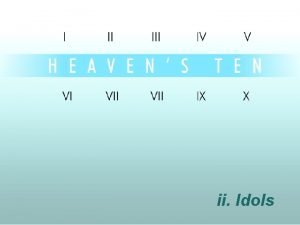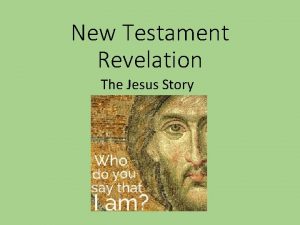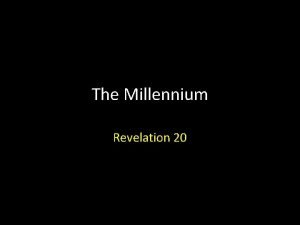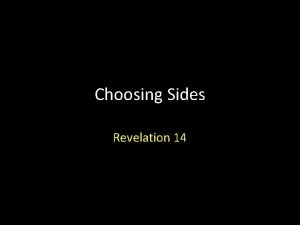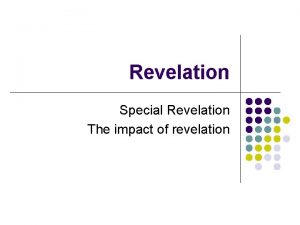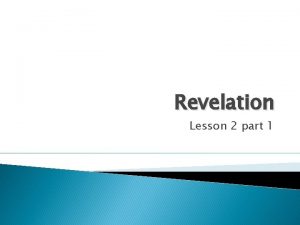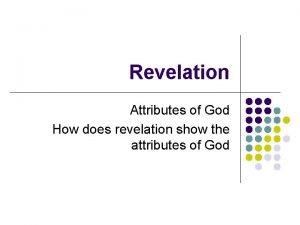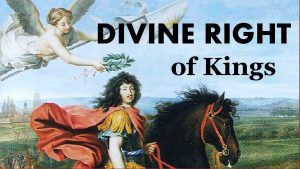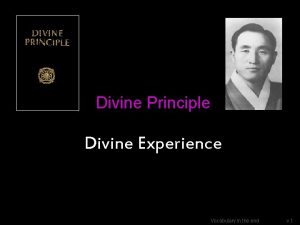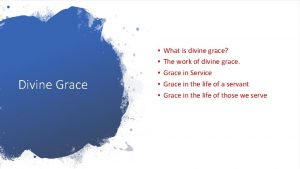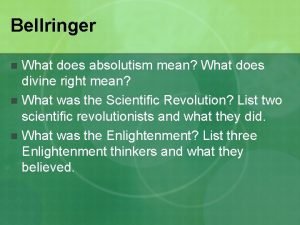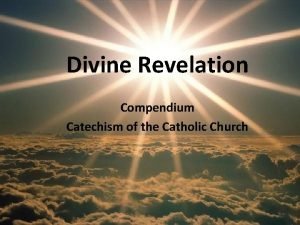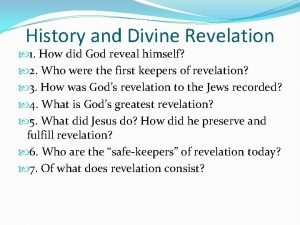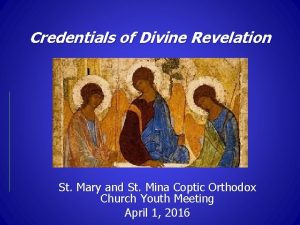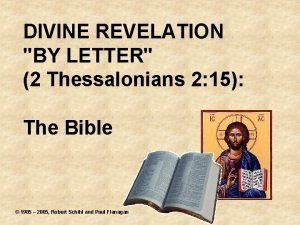Inquiry Class 2 Divine Revelation What does the



























































































































- Slides: 123

Inquiry Class 2 Divine Revelation What does the Catholic Church teach about: • • Sacred Scriptures Sacred Traditions • Inspiration • The Canon of Scriptures Let’s shed some light on these topics…

Before we begin… Let’s begin with prayer Prayer intentions…

Application After last weeks lecture If someone were to come up to you on Tuesday at work, and ask you one of two questions how would you answer? “You mean to tell me that God exists? Can you prove that to me? ” How would you defend the existence of God? “You tell me the Trinity is one, yet 3 what is that all about? ”

Divine Revelation is how God reveals Himself to us with truths of who He is. The ultimate revelation of God to us is with His Son, Jesus Christ, who is really the incarnation of God’s revelation. But there is quite a bit of Pre-Christian revelation that God gives us in humanity. First of all, last week, we looked at 8 ways we can come to know God. Through the use of natural reason, Looking at the beauty of the created universe, Seeing order of things in nature, Noting through this that there must be an Intelligent Creator.

Divine Revelation… Divine Revelation is God Himself breaking into this world and revealing Himself to us. Either naturally or supernaturally, Either way, we can come to know God through our conscience, and the light of natural reason;

Today’s focus… Our topic today is about how God reveals Himself to us supernaturally, There are many truths of our Faith that could not be known from the light of natural reason. One of them we talked about was the Trinity. We could have never figured out on our own that God is actually three Divine Persons, Father, Son, Holy Spirit, Yet, there’s only One God. We could not have come to that knowledge - God had to reveal that to us. What about Angels? God had to reveal that to us. – we could not figure this OUT!

It all starts with Creation God began revealing truths to the human race all the way back at the time of our first parents, Adam and Eve. This is something that we call public revelation. Public revelation is the official revealing of God to us, beginning with Adam and Eve, and ending at the death of the last Apostle, who was St. John the Evangelist, who died about the year 100 AD. All public revelation occurred during that time period from the existence of our first parents, and ended with the death of John the Apostle, John the Evangelist.

Public vs. Private Rev. Public revelation is different from private revelation. You might have heard of private revelations where sometimes the Blessed Mother appears to the children of Fatima, Or when Jesus appeared to St. Margaret Mary, and manifested the Sacred Heart. Many of the saints have appeared over the years to people. – private appearances These are all private revelations.

Private Revelation is… Not necessary for our salvation. Public revelation which ended with the death of the last Apostle helps us to attain salvation. The Church is not inventing any new doctrines or any new teachings. It was all revealed by God and ended during the Apostolic Age public vs. private revelation

What is the difference?


Pre-Christian Revelation The Pre-Christian (before Christ) revelation can be divided up into three sections 1. The first is called Primitive revelation is the revelation God made to Adam and Eve. 2. The second is Patriarchal revelation is how God revealed Himself to the patriarchs, namely Abraham, Isaac, and Jacob figures of the OT. 3. Finally, the Mosaic revelation, This is when God revealed Himself to Moses and the prophets. God began by speaking to Adam and Eve in the Garden of Paradise. He continued to speak to Abraham, to know him, and then He sent Moses to the Israelites. All of this was what we call Pre-Christian or Old Testament revelation.

Then along comes Jesus… With Jesus, we come to the fullness of God’s revelation, which is Christian revelation. This came because God sent His Son into the world, and Jesus is the revelation of God the Father. – John 3: 16 The Lord taught the Apostles, and He said, “Go out and preach the Gospel until the end of time. ” –Matt. 28: 20 He said, “Go therefore, and make disciples of all the nations. ” Matt 28: 19

Who is the author? Divine Revelation has God As its author, As its origin. Why? God can neither deceive nor be deceived. We know that what He reveals Either is through the Old Testament, or through Christ in the New Testament, Both are true.

Pillars of Revelation… There are two legs of Divine Revelation, 1. Sacred Scripture, 2. Sacred Tradition. Scripture comes from the Latin word which means “the writings. ” The bible is a collection of books or writings. And Tradition comes from the Latin word which means “what is passed down” or “what is handed on. ” Tradition is something that’s handed on.

Tradition – “handed on” You might have Christmas traditions, Easter traditions, Thanksgiving traditions, and Halloween traditions in your family; Something that is handed down. Scripture refers to the written Word of God; Sacred Tradition, refers to the spoken Word of God. Combined these are what’s called the two channels or two legs of Divine Revelation in this world.

Tradition - capital “T” Sacred Tradition is with a capital T. It’s not traditions of men that Jesus condemned in the New Testament. Sacred Tradition is the teachings (the verbal, the oral teachings) that have come down to us from the time of the Apostles.


Passages in Scripture Some passages that talk about Scripture and Tradition 2 Thess. 2: 15 – “To hold fast to the teachings that you have learned, whether by word, or by letter. ” This is a very important teaching, because it is something that would show the difference between Catholic teaching and Protestant teaching; One of the basis for the Protestant Reformation was their Doctrine called Sola Scriptura. Do you know what that means?

Sola Scriptura… Have all of you heard of that? Sola, meaning alone, Scriptura – Scripture alone. This is one of the cries of Martin Luther, saying that we don’t need the Church anymore; With his idea: All that we have is the Bible, All we need is the Bible.

No, we need SS and Tradition 2 Thess. 2: 15 - the teaching of St. Paul on this is very important. Why? He shows us why we believe in both Sacred Scripture and Sacred Tradition. Sola Scriptura was Martin Luther’s position that you don’t need the Church, you don’t need anything. All you need is the Bible. His claim was that if you have the Bible, then you have everything. We’ll see later how there is actually more than just the Bible, Remember, Jesus didn’t come to give us the Bible. He came to establish His Church. The Church is more than the Bible The Church is what gives us the seven sacraments, and the Bible, and the teachings of Christ.

2 Thess. 2: 15 refutes ML One of the passages that actually refutes Sola Scriptura in the Bible (and nowhere in the Bible does the Bible itself teach that Scripture alone has all that is truly necessary for salvation) is this quote, St. Paul told the Thessalonians, “Hold to the teachings you have learned, whether by word” (which is Sacred Tradition), “or by letter” (which is Scripture). – 2 Thess. 2: 15

Other passages… John, 21: 25. “There are, however, many other things that Jesus did. If every one of these should be written down, not even the world itself, I think, could hold the books that would have to be written. ” In other words, John is saying that what Jesus said and did is a whole lot more than what’s written in the Bible. St. John says that he doesn’t think the world could contain all the books it would take to write down everything that Jesus did and said. So not everything Jesus did and said is written down in Scripture -- Did he go to the bathroom?

Look a bit closer… In fact, even before the Scriptures were written, there was the Sacred Tradition These Traditions were the passing on of the truths that Jesus taught the Apostles. Jesus died roughly about the year 33, and then rose, and then ascended to Heaven; but the first books of the New Testament weren’t written until the 40’s, 50’s, 60’s, and some as late as the 90’s. You have this whole period between the life of Christ and the times that the Bible was written down, and during this time we refer to the Sacred Tradition, the passing on of the faith through the spoken word, and oral tradition.

Sacred Scripture first… Let’s focus on the Sacred Scriptures first, then we will talk about Sacred Tradition!

The Number of Books… The Scriptures are a composite of books. We will spend some time talking about the differences between the Catholic Bible and the Protestant Bible. The New Testament is identical. Both the Catholic and the Protestant New Testament have 27 books. The difference is that in the Old Testament, we have the 46 books of the Old Testament, whereas, the Protestants have 39. That means we have books in the Old Testament that the Protestant Bibles will not have.

Important to remember With Sacred Scripture, It is important to remember that the Bible is the Word of God. We treat it with great reverence and respect as Catholics. We know that it is inspired by God, The primary author of Scripture is God Himself even though He used human beings to write it down.

God is the Author! If you were asked the question, “Who is the primary author of Sacred Scripture? ” The answer is God – God inspired the Old Testament and the New Testament writers to write down these works. The Holy Spirit inspired Sacred Scripture. The writers were the instruments that God chose.

Bible = NT + OT All together, we have the books of the Old Testament and the books of the New Testament that combine into one book, which we call the Bible. This comes from the Latin word biblia, which means a collection of books, or a library. The Bible is whole library of books.

More on the bible? The books of the Bible were written over the course of 1300 years, This is from the time of Moses, (~1200 BC), to the time of St. John the Evangelist (~100 AD). The Bible was written mostly in three different languages over the course of this time: Hebrew, Aramaic, Greek

Inspired by God The writers were inspired by God, under the influence of the Holy Spirit. Their mind was enlightened Their will was moved to write what He wished. It is sort of mysterious how the writers of Scripture remained as free instruments. Their will was not forced in any way. They still had their free will. The writers still used their own styles. They were God’s instruments. God directed them and preserved them from writing error

God, the primary author God is the primary author of Sacred Scripture. The Bible is the Word of God, we owe it the greatest reverence and respect. In courtrooms, they ask you to place your hand upon the Bible (upon the Word of God). Solemn oaths are taken by placing your hand on the Bible. At Mass, when the Gospel is read, we all stand out of respect for the Word of God. The Bible has been read in every Catholic Mass for the last 2000 years (passages of Sacred Scripture).

Reverence for God’s Word At Christmas and Easter, and other times we incense the Word of God to show our respect and reverence for the Holy Word of God. We’ve had many Catholics over the years that were martyred, because they were safeguarding and defending Sacred Scripture. This is prevalent in the early Church where the Roman government was trying to burn and destroy copies of Sacred Scripture, and many Christians gave their lives to preserve the Word of God.

Bible – a historical record The Bible give us reliable historical records. Over the years, science has come, in their excavations, to reaffirm things that are present in Scripture. One event would be the fall of Jericho. They’ve done excavations in that part of the world (archeological digs), and they’ve found ruins of the walls of Jericho, which confirms what was mentioned in the Bible. The destruction of Sodom and Gomorrah has been shown through archeology. Evidence of the Great Flood.

St. Jerome One of the greatest events in the history of the Bible was about St. Jerome was commissioned by Pope Damasus. St. Jerome was the one who translated the Scriptures into the Latin, to get it into the language of the people. At the time, the Old Testament was in Hebrew, and the New Testament was in Greek. It’s important to remember that the Old Testament was largely written in Hebrew, and the New Testament was largely written in Greek. But then, about the year 400, the pope wanted the Bible to be brought into the language of the people.

More on St. Jerome was commissioned to translate the entire bible into the Latin language. It took about 35 years to translate the entire Bible into Latin. This translation into Latin is called the Vulgate.

What is the Vulgate? The Vulgate comes from the Latin word meaning the language of the people, or the common language. We get the word “vulgar” from this word. It doesn’t mean bad, it just means common language. Unfortunately, it has different connotations today, if somebody speaks in a vulgar way. But originally it meant the common tongue, the language of the people.

More on St. Jerome moved from Rome to the Holy Land. He lived in a cave at Bethlehem. While in the cave, he spent this time in prayer, and penance, and fasting. You may be asking yourself why did he move to Bethlehem? He moved to Bethlehem so he could work with the rabbis (the ancient rabbis) that knew the original languages. There he made his translation of the Vulgate, which is the official translation of the Church.

A good time for handouts Take a look at the handout called “The Making of the New Testament – The Catholic Church, Mother of the Bible. ” – Page 9 See here, we have the life of Christ, from basically one AD to 33 AD, even though Jesus was actually born between four and six BC, most likely, according to most modern scholarship. So, when the Lord died and rose from the dead, He ascended into Heaven, but he left on earth a Church. Remember, Jesus came to establish His Church. Then the Church is what wrote the New Testament, and then approved the books of the Old Testament.

The making of the NT Let’s say Jesus died around the year 33, rose, and ascended into Heaven. The first books of the New Testament weren’t written until between the year 42 and 97. You have several decades that the Church was preaching the Gospel and teaching, before even a word of the New Testament was written down. The Epistles and the Gospels were written, again between the years 42 to about the year 100. And then, between the year 100 and 393, there were several Gospels that were out there sort of floating around.

Other Gospels? ? ? There were about 50 Gospels that people could have been reading at the time. The unfortunate thing was that only four of them were authentically the inspired Word of God Matthew, Mark, Luke, John.

What other gospels? The Church had to examine all these other writings, things like: The Didichae, The Shepherd of Hermas, The letters of St. Ignatius of Antioch, The letters of St. Clement of Alexandria. The Church had to determine which of these were truly the inspired Word of God. How did they do this?

Which gospels were inspired? The Church, in 393, all of the bishops of the church gathered at the Council of Hippo, which is in northern Africa, came up with the Canon. What is a Canon? A canon is a Hebrew word meaning measuring rod. It is a list of inspired books. The Bishops of the Church are the ones who determined that these were the four Gospels (Matthew, Mark, Luke, and John) were the only four inspired by the Holy Spirit.

Bible formulated in 393 The New Testament books were determined at that time. They were added to the Old Testament Canon that the Church had as well. In the year 397 at the Council of Carthage, the Church again solemnly declared at the Council of Carthage, again in northern Africa, these lists of books. Even the Protestant scholars would accept this as historical data, that the bible is given to us by the Bishops of the Catholic Church and in the early Church there were many writings.

In the church, many writings… Some were: Authentic, Fraudulent, Not true, authentic writings. It was the Church that had to determine this, and it did this at Councils are when all the bishops of the Church would gather together, and then they would make their decision and give us a list of truly inspired books.

Then, the printing press! The next major event was in 1450, the invention of the printing press. The very first book ever printed on the printing press was the Catholic version of the Bible, by Gutenberg, who himself was a Catholic. It says here, in the right-hand column, 626 Catholic editions were printed in all languages. This helps us to realize the Church was not trying to keep the Bible away from the people; Rather, the Church was trying to get the Bible into the language of the people.

Thanks to St. Jerome That’s why the pope commissioned St. Jerome to translate it into Latin. As time went by, the Church translated the bible into: German, Italian, And into the other languages. It says 17 editions were made in Germany before Luther’s translation. This can hopefully clear up some misunderstandings.

In the movie, “Luther” A little while back a movie “Luther” came out. I don’t know if any of you got to see it One of the things it was saying was that it was Martin Luther who made the very first translation of the Bible into German. And once the people in Germany read this, they rejected the Catholic Church and said Sola Scriptura (all we need is the Bible). Well, the only problem is that there were already translations in German even before Luther was born.

Sorry, Luther Martin Luther was not the first one to translate it into German. It says here there were nine editions were published before Luther was born. If you look further down on the handout, we have the Douay- Rheims translation, and then the King James Version in 1611. So the official Catholic version is the Douay-Rheims. There are many other versions, and the revised Catholic version as well

Another handout Look at the handout “Where We Got the Bible. ”–Pages 2 -6 This is a very good article that was put out by St. Joseph’s Radio in California. It covers things we have already talked about; things like: The word Bible means a library of books; The bible was written over a span of 1, 300 years. It talks about how the Bible was compiled. It talks in the first paragraph of St. Jerome, who brought about the Vulgate. It says how the monks in the monasteries hand-copied the Scriptures over the centuries. So we owe a great debt of gratitude to the Benedictine monks, and to the Augustinians, and other orders that were around.

The monks… The monks were the ones, up until the printing press in the 1450’s that made copies of the Scriptures. And sometimes it would take a monk a lifetime of 10, 20, 30 years just to make one hand copy of Scripture. As you can imagine, these books were incredibly valuable. Sometimes you’ll hear anti-Catholics say, “Well, the Church tried to keep the Bible away from the people, and they had them chained in the monasteries. ” Now, that’s a true statement. They were chained, but when you spent 30 years of your life making a hand copy of Scripture, you didn’t want anybody to steal it, because these were incredibly valuable.

Chained bibles… They were chained in the monastery for the purpose of having them available for the people, not that they were trying to keep them away from the people.

An analogy… A good analogy would be when you go to a phone booth, The reason why they have phone books chained inside that phone booth is not to keep it away from you, but to make sure nobody runs off with it, so it’s available to you. Same with that little pen at the bank? Same reason – how they have that chain on the pen at the bank, it’s that idea.

Monks – calligraphy Sometimes you will hear people say the monks were the ones who translated and hand-copied these writings up until the invention of the printing press. Some of these were so beautiful. They had calligraphy and just great works of art. It says in this article that there were over 600 Catholic Bible editions, 200 in the vernacular (the word vernacular means the common language of the people) before the first Protestant version appeared. The first book ever printed was a Catholic Gutenberg Bible, in 1456.

Manuscripts = hand written Now the original manuscripts were written by hand. They were just incredibly valuable. An interesting point on page five on the handout…:

Did we ban bibles? Sometimes you hear people say, “Well, did the Catholic Church ever ban certain Bibles or burn certain Bibles? ” And of course the answer is yes, because some of them contained grave errors and mistakes. You’ll see a list of some of them. For example, one of them was called the Wicked Bible, because instead of saying, "Thou shalt not commit adultery, ” it said, “Thou shalt commit adultery. ” Obviously, you wouldn’t want that Bible out there for people to follow. The next one talks about instead of, “Let the children first be filled, ” like filled with bread, or filled with food; it said, “Let the children first be killed. ” You can understand why some of these Bibles had to be done away with. They destroyed them and burned them

Myths… Sometimes you’ll hear sort of anti-Catholic attacks, like the Church was trying to keep the Bible away from the people. This was not the case. The Church was trying to protect its children from going astray.

Church – A Mother The Church is a good mother, and any good mother does not want her children reading immoral things or bad things. You want your child reading good, wholesome things that will help you get to Heaven. This is an explanation on why the Church had to act on some of these occasions. You can just read the rest of that on your own. There a lot of good points.

SS is to be reverenced! The main thing we need to remember about Sacred Scripture is that we read it, we revere it, we love it – it’s the inspired Word of God. Realize where the Bible came from. The Bible was not written by Christ. In fact, Jesus only wrote one thing in His life, according to the Bible -- and that was in the sand, which is not a very permanent place.

An important distinction Sometimes people say, “Well, why didn’t Jesus write anything? ” One author put it this way. He said, “Jesus didn’t really want people to focus on His writings, like we do with Shakespeare, where we really don’t study the man of Shakespeare, we study his writings. Because Jesus didn’t write anything, we focus on the person of Christ, as our Lord and Savior, as the Son of God. ” We don’t focus on His writings, because He didn’t leave us anything. He left us the Church. He left us the seven sacraments. He left us Himself. So, we as Christians focus on the person of Christ.

Another view… Another way to look at Scripture, we could ask ourselves, “What came first, the Bible or the Church? ” That’d be like asking the question, “What came first, the Founding Fathers of our country, or the Constitution? ” And of course, the Founding Fathers have to be there first before the Constitution was written. It’s the same thing with the New Testament. Realize that the Church is the author and the mother of the New Testament.

Half way point… Questions, comments, or concerns Is there anything from this material, that needs to be clarified?

Bible did not fall into our laps from the sky ! Sometimes people will say, “Well, I have my Bible, that’s all I need. ” Well, again, where did the Bible come from? It didn’t fall down out of the sky from Heaven, in the year 1611, in the King James translation. It actually came from other translations, all the way back to what was approved by the Church, back in the 300’s. Nowhere does the Bible tell us what books are in the Bible. It had to be the Church that determined the Canon, or the list of inspired books. If somebody were to reject the authority of the Catholic Church, they would have to reject the authority of the Bible.

Who interprets the Bible? Where does the Bible come from? How do we know that the Bible is the inspired Word of God? The answer is that the Church tells us that these books are the inspired Word of God. By rejecting the Church, really a person would have to reject Sacred Scripture as well.

A couple other handouts This one here, we could call it “The Cheat Sheet” Page 23 -37 - This has topics you might be interested in learning what the bible says about some of these topics It has all the Scripture quotes that relate to that topic, which would be very helpful to you if you wanted to look up the Eucharist, the Pope, the Divinity of Christ, the Second Coming of Christ, Mary, the Saints, Heaven, Hell, Purgatory, the teachings on Matrimony, and other teachings. Use it, it is a very helpful handout.

Another handout? ? ? I’d also recommend you reading this one on pages 7 -8. The article is called “Is the Bible a Catholic Book” This article covers and reinforces some of the things we have already discussed.

Another article in the handout “The Bible Timeline. ” – page 10 – 22 This was developed by Jeff Cavins. He was a convert from Protestantism to Catholicism. His goal was to try and help Catholics read the Bible more. The Protestants really do a phenomenal job in preaching the Word of God and in encouraging their people to read the Bible This is something we can definitely learn from them.

The Bible Timeline… This explains how the bible is divided up into 12 periods: The Early World, The Patriarchs, Israel and Egypt, Conquest of Canaan, The Judges, United Kingdom, Divided Kingdom, The Exiles, The Return, The Maccabean Revolt, Jesus the Messiah, The Church.

A guide to read the bible Pages 13 -17 of your handout What the author is recommending is that you can actually read the Bible through in a narrative, chronologically, and reading the Bible history. There are many books in the Bible that are just giving advice and wisdom. If you just want to read the storyline, this is recommend. You can read the Bible in a full year just by reading four chapters a day. If you read it this way, you will see how the bible is divided up by the outline of the Bible periods

Pages 18 -21 This is really a summary of the entire Old Testament, beginning with the history of the early world and creation, approximately 2000 BC, It refers to the fall of Adam and Eve, Cain killing Abel, The Flood, The Tower of Babel.

Pages 18 -21 Then there’s the period of the Patriarchs: Abraham, Isaac, Jacob, Joseph, from about 2000 to 1600 BC. Then the time that the Israelites spent in Egypt in slavery, then Moses and the Passover, and the covenant on Mt. Sinai. Then, the Conquest of Canaan, from 1280 to 1220 BC

Pages 18 -21 Then, the death of Moses, Joshua, the time of the Judges, Debra, Gideon, Samson, all those stories, from about 1220 to 1050 BC. Then, the United Kingdom, the story of King Saul, David and Goliath, that was about 1000 BC. The Divided Kingdom, between the Northern Kingdom and the Southern Kingdom, 930 to 722 BC. The Dark Days, and then The Exile, when the Israelites were exiled from their native land, 722 to 538, and then they returned to Jerusalem. And Queen Esther and those stories, up until 530 BC. Then, the Maccabean Revolt, from 175 to 63 BC, and then the Time of Christ, zero to 33 AD, and then the Church, from 33 to 63.

Bible – 2000 BC to 63 AD The Bible covers, from approximately 2000 BC to 63 AD. This tool is an amazing gift that Jeff Cavins has given to the Church, so that we can now read the chronological books of Bible history. If you just want to get the story line, over here on page 22, If you hold it sideways, you’ll see that if you just read these 14 books, you can get the whole story line of the Bible: Genesis, Exodus, Numbers, Joshua, Judges, Samuel 1 and 2, Kings 1 and 2, Ezra, Nehemiah, Maccabees, the Gospel of Luke, and the Acts of the Apostles. That will give you the full story line from Adam and Eve up until Pentecost.

Bible can be daunting… A lot of people start out when they don’t have a guide or something like this, and they will say, “I’m going to read the whole Bible this year. ” They start out and read Genesis, and Exodus, and then they sort of get bogged down in Deuteronomy and other books, and they never get through the Bible. If you stick with these 14 books out of the 73, you can get the whole storyline.

A bit more…OT As we survey over the 46 books of the Old Testament Make yourself aware of them, familiarize yourself 21 - are called Historical books, relating to the earliest ages of the world, the history of the Jews, 5 - books of Moses, 4 - books of Kings. 7 - Doctrinal books, These are the words of advice, and the maxims and prayers, such as the Psalms, and the book of Proverbs. 18 - Prophetic books, 4 great prophets, 12 lesser prophets, such books as Isaiah, Jeremiah, and the book of Daniel.

A bit more…NT As we survey the New Testament, there are 27 books, 4 Gospels (Matthew, Mark, Luke and John), The Acts of the Apostles – life in the early church, 21 Epistles These were written by St. Paul, St. Peter, St. James, St. John, and St. Jude, The book of Revelation – which was written by St. John

Sacred Tradition! Sacred Tradition is often misunderstood and is something that some people get confused about. Divine Revelation comes to us in two ways, Sacred Scripture, Sacred Tradition. In the wide sense, Sacred Tradition embraces the whole teaching of the Church, which includes the Bible, since it is only from the Church that we have the Bible. In the stricter sense, Sacred Tradition includes what was handed down orally, or verbally, from the Apostles

Tradition in SS The Apostles themselves say that there is much that has been delivered to the faithful by word of mouth. 2 John 1: 12 – Although I have much to write to you, I do not intend to use paper and ink. Instead, I hope to visit you and to speak face to face so that our joy may be complete. 1 Cor. 11: 2 – I praise you because you remember me in everything and hold fast to the traditions, just as I handed them on to you.

Traditions not mentioned in SS Among many examples of the truths and Traditions not clearly manifested in Scripture, are: The exact number of the sacraments, The time and institution of some of the sacraments, The books themselves that make up the Bible, Baptizing babies, - Acts – whole households Observing Sunday as the Lord’s Day, The Trinity, The Assumption of the Blessed Mother, Mary’s Immaculate Conception

Tradition and not just SS These examples are just some of the things that are clearly talked about in Sacred Tradition that we have from ancient Church documents that are not specifically referred to in the Bible. These are some of the things that could separate the Catholic Church from some of the Protestant Churches. But, if you go by Scripture alone, some of these teachings aren’t as clear in the Scripture without Tradition.

Ancient Church Writing When you look into the ancient Church writings, like the writings of the Church Fathers, you’ll see these clearly talked about as practices that existed in the early Church. For example, keeping Sunday as the Lord’s Day; now, all Christian Churches do that, but where do we get that Tradition of worshiping God on Sunday, instead of on Saturday? Because, as you know, to the Jews, the Sabbath is Saturday. Why is it that we actually all go to Church on Sundays, even in the Protestant Churches? Well, it’s because of the Tradition from the early Church.

Without Tradition – what is the Trinity? Another thing without Tradition, we don’t understand the Trinity. You will nowhere find the word Trinity anywhere in the Bible, yet all Christians believe in the Trinity. It is part of the ancient writings, of the early Church Fathers. Mary’s Assumption is very clearly talked about in some of the ancient writings that Mary was taken up into Heaven, body and soul, at the end of her earthly life.

Tradition is NEEDED! Mary’s Immaculate Conception is not understood without Tradition. The number of books that are in the Bible, and which books make up the Bible is not understood without Tradition. All of these are a part of the Sacred Tradition.

Church Fathers All the truths of Divine Tradition now have found their way into books. From the first Christian centuries, the practices and Doctrines of Tradition were preserved by saintly teachers whom we called the Fathers of the Church. The most important Fathers of the Church of the first six centuries, are: St. Clement of Rome, who died in the year 99 AD, St. Ignatius of Antioch, who died in 107, St. Polycarp, who died in 155, St. Justin Martyr, St. Irenaeus, St. Cyprian

Doctors of the Church Besides the writings of the Fathers of the Church, we have the writings of the Doctors of the Church. The word Doctor comes from the Latin word meaning teacher. We have ancient Doctors of the Church as well. Currently in the Church, there about 33 or 34 saints who are Doctors of the Church. These were Church writers who were known for their learning, and their holiness of life.

How does a saint become a doctor To become a Doctor of the Church, They had to write extensively about theology. They would also have to be a saint to be considered one of the Doctors of the Church.

Who are the doctors of the Church Now, among these would be: St. Hilary, St. Ephrem, St. Cyril of Jerusalem, St. Ambrose, St. Jerome, St. Cyril of Alexandria, St. Leo the Great, St. Athanasius, St. Basil the Great, St. Gregory Nazianzus, St. John Chrysostom, St. Augustine, St. Peter Chrysologus, Pope Gregory the Great. These were what we called the ancient Fathers and Doctors of the Church included are three women.

Why do we need Sacred Tradition Some of the reasons why we need Tradition is that not everything found its way into the Bible, There was several years, even decades that passed, before any of the Gospels were written down.

During this time without SS The Christians were preaching, and baptizing, and having the Mass, and sharing the Eucharist. They were living their Faith; they were practicing the faith even before a word of the Bible was written down. Sacred Tradition is actually older than the New Testament. The Gospel of John and the Book of Revelation were probably written between the years 90 and 100 AD, and yet the Church was existing from 33 AD. Jesus, actually, when he told the Apostles, He didn’t say, “Go out and write a book, ” He said, “Go out and preach the Gospel to every creature, baptize them in the Name of the Father, Son, and Holy Spirit

All doctrine comes from the Apostles Every single doctrine that the Church teaches comes directly from the Apostles. The Church is not inventing any new doctrines. Any of the things that we believe as Catholics today, on these issues of Faith and Morals, were found in seed form in the early days of Christianity.

Doctrine never changes Things like The Divinity of Christ, the Resurrection, the Seven Sacraments. Even though we understand a lot more about them now, these teachings began in the early Church. There has been development of doctrine, but there’s not a change in doctrine.

Some examples… We can use the example that a young boy becomes a man, but he’s still the same person. The seedling, or the acorn, becomes the tree, but still the same in essence. Many of these doctrines that the early Christians only understood in seed form, we know a lot more about them today. It was revealed to them that yes, God is a Trinity (Father, Son and Holy Spirit). We know a whole lot more about the Trinity now than the early Christians did in the year 100. It’s the same doctrine, the same teaching; but it’s been unfolded.

Another analogy… Another analogy is when you come in from the outside sunlight, you come into a dark room, and it takes a while for your eyes to adjust. When you do this, you make out the table and chairs. Those pieces of furniture are there already, but it’s just that we get more and more accustomed to be able to see them in more detail. It’s the same thing with the doctrines of the Church. The more time goes by, we can reflect upon these doctrines and understand them a lot more.

Scriptural Interpretation How do we interpret the teachings of Scripture? The Bible itself says that there are some passages that are difficult to interpret. St. Paul has many writings in the New Testament. In one of St. Peter’s letters, referring to the Epistles of Paul, he says that, “they contain certain things difficult to understand, which the unlearned and the unstable distort, just as they do the rest of Scripture, to their own destruction. ” That’s found in 2 Peter 3: 16

Not easy to understand Not everything in the Bible is easy to interpret or to understand. Now, a proof of that is that currently, in America today there are 36, 000 different Christian denominations. Did you know that? 36, 000 different denominations have broken off of the Catholic Church. And most of them claim to believe in Sola Scriptura, the Bible alone.

Personal interpretation? What happens when you have personal or private interpretation of Scripture is that it leads to the breakdown of the one true faith, and then you have splintered groups that break off, and each one will hold different things. The Mormons believe one way of interpreting; the Jehovah Witnesses another. The Presbyterians, Lutherans, Methodists, Episcopalians, and now in America we have ~36, 000 different denominations. Who interprets this?

Personal interpretation What happens with personal interpretation is that people can take things out of context, and then they’ll start their own religion. For example, in some of the early days of Protestantism, some of them said, “Yes, it’s okay to baptize babies. ” Others said, “No, you have to wait until they’re old enough to make their own decision. ” Well, after they argued, they just decided to split, and they each started their own denomination.

Who helps us? Where do we get our interpretation of Scripture? We get it from the Church. Remember, the Church was founded by Christ. The Church: Was here before the New Testament. Interprets the Bible for us. Is the Mother of the Bible. Is guided by the Holy Spirit, to interpret the Bible correctly.

An example… Let’s say you’re using a textbook in a classroom, and you’re not sure exactly what the author meant. Well, how do you find out? You go to the author and say, “Can you clarify that? ” And the author would say, “Yes, this is what I meant when I wrote this particular passage. ” That’s what we do with the Bible. If there are passages that are difficult to interpret, we go to the Church and see how has the Church always interpreted that passage; and that’s, we believe, inspired by the Holy Spirit. Since Christ said to St. Peter, “You are Peter; upon this rock I will build My Church, and the gates of Hell will never prevail against the Church. ”

The HS guides the Church The Church will never fall into error on issues of Faith and Morals. The living voice of the Church interprets Sacred Scripture The Church guides us to proper interpretation.

Another Analogy I guess another analogy would be in the Constitution Where would we go to get an interpretation? You go to the Supreme Court. You go to a living voice that can make an interpretation of the Constitution. When you have the Bible, where do you go to get the proper interpretation? You go to the Church.

7 Books gone missing… Let me now go into the seven books that are found in the Catholic Bible that are not found in the Protestant version of the Bible. The handout is called “The Canon of the Bible. ” Pages 38 -40


Why do we differ? How is it that we wound up with a different Old Testament than the Protestant Church? This handout is the very best explanation that I’ve come across. Take a look, where it says on page 38, the Old Testament – Why Do Catholic and Protestant Bibles Have a Different Number of Books in the Old Testament?

Let’s Explore As I mentioned, our New Testament is identical: 27 books. The answer to why there is a difference in Old Testament books between the Catholic bible and Protestant Bible is The Protestant Old Testament is based upon the Palestinian or the Hebrew Canon used by the Hebrewspeaking Jews in Palestine. The Catholic Old Testament is based on the Alexandrian, or Greek Canon used by the Greek speaking Jews throughout the Mediterranean, including Palestine. The difference is Hebrew and Greek!

Hebrew or Greek? ? ? The article explains that the city of Alexandria (Greek, Catholic version) in Egypt had the greatest library, In this library, there were 70 or 72 scholars that translated the Scripture - the entire Old Testament Hebrew Bible they translated into Greek. The Septuagint is the name of the Greek translation of the Hebrew Old Testament.

Why fewer books? “Why are there seven fewer books in the Hebrew Canon? ” The answer is the Hebrew Canon was established by the Jewish rabbis at Jamnia in Palestine about 100 AD, perhaps in reaction to the Christian Church, which was using the Alexandrian Canon. The Jews at Jamnia rejected seven books from the Hebrew Canon found in the Septuagint.

What are the 7 books? These are the names of the seven books that the Protestant Bibles won’t have: Acronym to remind us: To Serve John Wayne Beer I and II Books include: Tobit Sirach Judith, Wisdom, Baruch, First Maccabees Second Maccabees, As well as some portions of Daniel and Esther,

Why are they rejected? They are rejected chiefly on the grounds that they could not find any Hebrew versions of these books, which the Septuagint supposedly translated into Greek. That was their main argument, that they couldn’t find Hebrew versions of these seven books. The Christian Church continued to use the Septuagint.

Uncontested for centuries When the Church officially decided which books should comprise the Canon of the Bible, at the Councils of Hippo and Carthage, in 393 and 397, it approved the 46 books of the Alexandrian Canon as the Canon for the Old Testament. For sixteen centuries, the Alexandrian Canon was a matter of uncontested faith Then what happened?

What do we know about these 7 books from history Each of the seven rejected books is quoted by the early Church Fathers as Scripture, or as inspired right along with the undisputed books. That’s an interesting point that the early Fathers like Ignatius of Antioch, and Clement of Rome, when they quoted, they were using some of these seven books in their writings. Along comes Martin Luther in 1529, and what he did, he decided to go with the Palestinian Canon of 39 books, the Hebrew Old Testament.

Why did Luther do that? The reason why he did this, as Luther found justification for removing the seven books from the Bible, in the old concerns of St. Jerome, and the Council of Jamnia, that the Greek books had no Hebrew counterparts. However, the Dead Sea Scrolls were found. Remember, in 1949 or so, the Dead Sea Scrolls were found, and they discovered at Kumran ancient Hebrew copies of some of these disputed seven books, making their rejection unsupported on those grounds.

Dead Sea Scrolls… You might remember the story, I think it was 1940 or 1949, there was a shepherd boy near the Dead Sea, and some of his sheep had gone into a cave. He threw a rock in to try to get the sheep out, and he heard a crack. He walked in, and he had broken open one of these ancient jars, which had been sealed. He found all these scrolls and manuscripts, called the Dead Sea Scrolls.

More info… You can research “Dead Sea Scrolls” on the Internet, and you can buy books now. Finding these scrolls was good for us. In these scrolls, they found that some of these scrolls contained Hebrew versions of some of these seven books. Since then, many of the Protestant scholars have accepted these seven books as the inspired Word of God as well.

Now What? ? ? In almost all the Protestant Bibles, even though they might not put them in the text of inspired works, at least they put them in the back of the book, saying that these may or may not be the Word of God. The discovery of the Dead Sea Scrolls does support the Catholic Old Testament Canon of 46 books, rather than the Hebrew Old Testament Canon of 39.

What impact does this have? What impacts do these seven books missing have on the Faith? One of the reasons why Luther rejected them is because they are very Catholic books. First and Second Maccabees say that, “It is a just and holy thing to pray for the dead, that they may be loosed of their sins. ” That is basically our teaching on Purgatory; that our prayers can still help people that have died. The sins that we pray they will be loosed from are not mortal sins; they are smaller sins (imperfections, weaknesses), so we pray that our prayers can still help people when they die.

Rejected to match Luther Theology One of the reasons why Luther rejected these seven books is because they contained a lot of Catholic theology, He was trying to reject that. That’s one of the things that these books refer to, namely the importance of praying for the dead. Now, if there’s only Heaven and Hell, there’s no need to pray for the dead, because if somebody’s in Heaven, they don’t need prayers; if they’re in Hell, they can’t be helped by our prayers. The fact that these books talk about praying for the dead would support that there is a third place that people could go besides Heaven or Hell – that our prayers could help them.

ML acknowledges Church Martin Luther admitted that they owed a debt of gratitude to the Catholic Church. If you look on page 40, it says, “Historically, the Catholic Church used her authority to determine which books belonged to the Bible, and to assure us that everything in the Bible is inspired. Apart from the Church, we simply had no way of knowing either truth. ” Martin Luther himself admits, “We are obliged to yield many things to the Papists, ” (to the Catholics), “that they possess the Word of God, which we receive from them, ” (namely, we the Protestants who were protesting); “otherwise we should have known nothing at all about it. ”

Luther recognizes… Luther is admitting that Christians owe their Bible to the efforts of the Catholic Church. Luther’s statements support our argument that without the decisions of the Church, we would not know which books of the Bible are inspired. – that is Tradition St. Augustine says, “I would put no faith in the Gospels, unless the authority of the Catholic Church directed me to do so. ” Augustine recognizes the only way to determine which books are inspired is to accept the teaching authority of the Church

What are the Catholic Bibles of today ? There are many different Catholic translations out there. Two of the most common are the New American Bible, and the Revised Standard Version Bible. You can read the New American Bible, which is what we have at Mass. There’s the Jerusalem Bible, the New English Bible, the New International Version, and really, they say the best Bible is the one that you read – the best translation is the one that you’ll pick up and read. The main thing is to read your Bible every day. You know, a priest reads the Bible between 30 to 45 minutes every day, because he prays the Liturgy of the Hours. Every priest and every nun reads Scripture that much every day. We should all read the Bible and make use of it.

Love letters We have this great treasure, this love letter written by God to us; and we have this Bible, and yet so many times it’s just covered in dust. What you need to do is wipe the dust off it, and start reading it; Where do I start? I would recommend start with the Gospels. Start with Matthew, Mark, Luke, or John, and then read the Acts of the Apostles, and after that, then finish the New Testament, and then go back to Genesis, and then read through the Old Testament. Start with the Gospels, they’re the easiest. It’s the life of Christ, then go to the Letters of St. Paul, and then go back to the Old Testament.

Next Week… Next week – we will talk about: Creation and Angels Science and Evolution Original Sin Reading Assignments for next week: Catechism of the Catholic Church Paragraphs 198 -421 Catholicism for Dummies Pages 36, and 305 -306 If you have any questions when you read, please right them down and either ask them at the lecture, or email me.

Discussion – 4 minutes Break into small groups of 3 or 4, with someone you have not yet met in class Where was I closest to God this past week or where have I felt God’s presence? What is my favorite book of the bible and why? (If you don’t have a favorite book, talk about a verse which might be your favorite verse. ) If you don’t have a favorite verse, ask others how they approach reading the bible?
 Divine revelation definition
Divine revelation definition 2 pillars of divine revelation
2 pillars of divine revelation Divine revelation definition
Divine revelation definition Salvation history in the old testament
Salvation history in the old testament The living word the revelation of god's love
The living word the revelation of god's love Why is creon upset at the opening of scene 2?
Why is creon upset at the opening of scene 2? Hình ảnh bộ gõ cơ thể búng tay
Hình ảnh bộ gõ cơ thể búng tay Bổ thể
Bổ thể Tỉ lệ cơ thể trẻ em
Tỉ lệ cơ thể trẻ em Gấu đi như thế nào
Gấu đi như thế nào Thang điểm glasgow
Thang điểm glasgow Bài hát chúa yêu trần thế alleluia
Bài hát chúa yêu trần thế alleluia Các môn thể thao bắt đầu bằng tiếng chạy
Các môn thể thao bắt đầu bằng tiếng chạy Thế nào là hệ số cao nhất
Thế nào là hệ số cao nhất Các châu lục và đại dương trên thế giới
Các châu lục và đại dương trên thế giới Công thức tính thế năng
Công thức tính thế năng Trời xanh đây là của chúng ta thể thơ
Trời xanh đây là của chúng ta thể thơ Mật thư tọa độ 5x5
Mật thư tọa độ 5x5 Phép trừ bù
Phép trừ bù độ dài liên kết
độ dài liên kết Các châu lục và đại dương trên thế giới
Các châu lục và đại dương trên thế giới Thơ thất ngôn tứ tuyệt đường luật
Thơ thất ngôn tứ tuyệt đường luật Quá trình desamine hóa có thể tạo ra
Quá trình desamine hóa có thể tạo ra Một số thể thơ truyền thống
Một số thể thơ truyền thống Cái miệng nó xinh thế
Cái miệng nó xinh thế Vẽ hình chiếu vuông góc của vật thể sau
Vẽ hình chiếu vuông góc của vật thể sau Biện pháp chống mỏi cơ
Biện pháp chống mỏi cơ đặc điểm cơ thể của người tối cổ
đặc điểm cơ thể của người tối cổ V cc cc
V cc cc Vẽ hình chiếu đứng bằng cạnh của vật thể
Vẽ hình chiếu đứng bằng cạnh của vật thể Phối cảnh
Phối cảnh Thẻ vin
Thẻ vin đại từ thay thế
đại từ thay thế điện thế nghỉ
điện thế nghỉ Tư thế ngồi viết
Tư thế ngồi viết Diễn thế sinh thái là
Diễn thế sinh thái là Dạng đột biến một nhiễm là
Dạng đột biến một nhiễm là Số nguyên tố là gì
Số nguyên tố là gì Tư thế ngồi viết
Tư thế ngồi viết Lời thề hippocrates
Lời thề hippocrates Thiếu nhi thế giới liên hoan
Thiếu nhi thế giới liên hoan ưu thế lai là gì
ưu thế lai là gì Hổ sinh sản vào mùa nào
Hổ sinh sản vào mùa nào Khi nào hổ con có thể sống độc lập
Khi nào hổ con có thể sống độc lập Sơ đồ cơ thể người
Sơ đồ cơ thể người Từ ngữ thể hiện lòng nhân hậu
Từ ngữ thể hiện lòng nhân hậu Thế nào là mạng điện lắp đặt kiểu nổi
Thế nào là mạng điện lắp đặt kiểu nổi Are you going to class today
Are you going to class today Package mypackage class first class body
Package mypackage class first class body Introduction to ooad
Introduction to ooad Measures of central tendency for grouped data
Measures of central tendency for grouped data Class i vs class ii mhc
Class i vs class ii mhc Abstract concrete class relationship
Abstract concrete class relationship Size of class interval
Size of class interval Stimuli vs stimulus
Stimuli vs stimulus Stimuli vs stimulus
Stimuli vs stimulus 7 rights of medication administration in order
7 rights of medication administration in order Class maths student student1 class student string name
Class maths student student1 class student string name Unordered stem and leaf plot
Unordered stem and leaf plot In greenfoot, you can cast an actor class to a world class?
In greenfoot, you can cast an actor class to a world class? Static class loading and dynamic class loading
Static class loading and dynamic class loading Class 0 esd
Class 0 esd Static uml diagrams
Static uml diagrams Class 2 class 3
Class 2 class 3 Extends testcase
Extends testcase Package mypackage class first class body
Package mypackage class first class body Class third class
Class third class Uml private public protected
Uml private public protected Component class has composite class as collaborator
Component class has composite class as collaborator The divine praises prayer
The divine praises prayer Divine council worldview
Divine council worldview Human language is a result of divine gift
Human language is a result of divine gift Manhood (law
Manhood (law Divine comedy 3 parts
Divine comedy 3 parts Terza rima dante
Terza rima dante Society of divine vocations
Society of divine vocations Divine turn around
Divine turn around Holy trinity explained
Holy trinity explained Divine command theory and euthyphro dilemma
Divine command theory and euthyphro dilemma Divine principle 3 hour lecture
Divine principle 3 hour lecture Divine machinery
Divine machinery Divine it limited
Divine it limited Divine intervention episode 95
Divine intervention episode 95 What is intellectual virtue
What is intellectual virtue Divine command theory
Divine command theory Natural law ethics
Natural law ethics Divine destiny definition
Divine destiny definition Oh love divine how sweet thou art
Oh love divine how sweet thou art Windows of wisdom
Windows of wisdom What are the three divine institutions of god
What are the three divine institutions of god Divine comedy purgatory structure
Divine comedy purgatory structure Revelations of divine love summary
Revelations of divine love summary The divine source of language
The divine source of language Divine intervention usmle
Divine intervention usmle Divine righteousness
Divine righteousness Divine pedagogy
Divine pedagogy Divine mercy college foundation inc. caloocan city
Divine mercy college foundation inc. caloocan city Divine economy definition
Divine economy definition Keys to divine visitation
Keys to divine visitation Walking in the favor of god
Walking in the favor of god Divine institution meaning
Divine institution meaning The child archetype
The child archetype To iterate is human to recurse divine
To iterate is human to recurse divine O sacrament most holy hymn
O sacrament most holy hymn Divine right clipart
Divine right clipart Come holy spirit, come hymn
Come holy spirit, come hymn The divine wind summary
The divine wind summary Divine right theory government
Divine right theory government Divine right
Divine right Exposition of the divine principle
Exposition of the divine principle Elyon god
Elyon god Divine principle powerpoint
Divine principle powerpoint Divine command theory strengths and weaknesses
Divine command theory strengths and weaknesses Sinon the divine comedy inferno
Sinon the divine comedy inferno Divine right theory government
Divine right theory government Be blessed by the divine
Be blessed by the divine Oblique asymptote definition
Oblique asymptote definition Bright sun divine monarch
Bright sun divine monarch Divine natalie white pack
Divine natalie white pack Signs and symbols of holy matrimony
Signs and symbols of holy matrimony The father of spirits
The father of spirits Divine exodus
Divine exodus Examples of identity diffusion
Examples of identity diffusion
